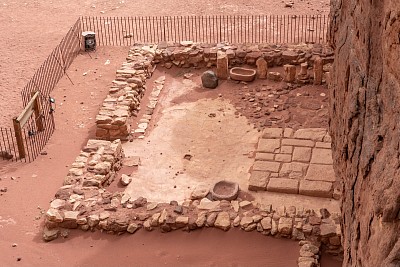Beliefs and worship in Midianite Yahwism
Beliefs
Midianite Yahwism was likely monolatrous, this means the worship of only one God, whilst allowing for the existence of other deities. YHWH was likely worshipped as a chief mountain and sky deity by the Midianites, they believed He performed multiple functions, including the functions of a storm and warrior God which are mentioned in the early Yahwistic poetry. He was also connected to metallurgy.
Midianite worship was aniconic meaning that they did not use images to represent God. According to Prof Israel Knohl, the Israelite prohibition against idolatry may originate with the Midianites. He mentions that biblical Kina (now Horvat Uza) which was inhabited by Kenites did not contain images or figurines. Knohl mentions that the Midianites shared a temple in Timnah with the Egyptians. When the Egyptians left, the Midianites made the site religiously acceptable by destroying the images of the Egyptian goddess Hathor.
Worship and rituals
Worship in early Yahwism consisted of prayers, blessings and sacrifices (Exodus 3:18, Exodus 18:10). The sacrifices consisted of a ritual meal shared by worshippers which was common in pre Islamic Arabia. A Midianite tent sanctuary discovered by archaeologists at Timna contained a row of massebot (standing stones), sandstone basins, incense altars and offering benches. Votive offerings left at the site included Qurayyah painted ware, jewellery and small metal votives. These discoveries confirm that animal sacrifice was practised by the Midianites and suggest that incense burning, metallurgical rituals and votive offerings were also part of Midianite rituals. The Midianite worship area did not contain any images.
Festivals and other customs
The early Yahwists likely made periodic pilgrimages to sacred sites for sacrifices and feasts, this was common in pre Islamic Arabia. The earliest Yahwistic pilgrimage sites were likely in the southern region where Yahwism originated. There is evidence of ritual meals involving the eating of goats and sheep at the Midianite tent shrine at Timna. The Midianites may have also practised circumcision, this ritual was performed by the Midianite wife of Moses, Zipporah.
According to some scholars, the Kenites celebrated a Passover like feast in the spring when the lambs were born. Scholars have long thought that the origins of Passover lay in early shepherds customs before the herds were taken out to spring pastures. The firstlings of the flock were sacrificed in petition for a good year for their flocks and families. After the sacrifice, the meat of the animal was eaten in a sacred meal. This festival was later associated with the Exodus in Israelite Yahwism.
Sources:
YHWH: Origin of a desert God, Robert Miller II
YHWH the original Arabic meaning of the name, Prof Israel Knohl
Jacob Edward Dunn, 'A land whose stones are iron and from whose hills you may mine copper, metallurgy pottery and the Midianite Qenite Hypothesis'.
The Rise of Yahwism: the role of marginalised groups Marlene Mondriaan
The Archaeology of Cult of Israel’s Southern Neighbours and the Midianite-Kenite Hypothesis, Juan Manuel Tebes.
Andre Lemaire, The Birth of Monotheism
Arabia and the Arabs, Robert G Hoyland

